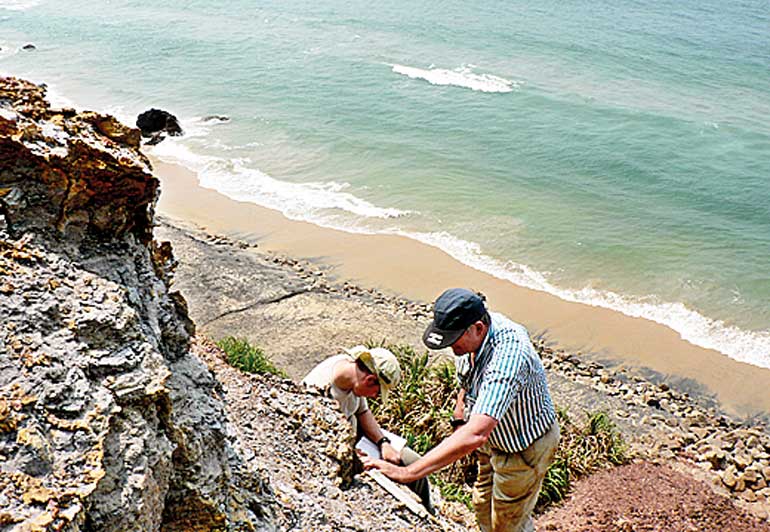Friday Feb 14, 2025
Friday Feb 14, 2025
Wednesday, 17 August 2016 00:01 - - {{hitsCtrl.values.hits}}

Kerala 
Kutch


Prof Mathias Harzhauser
The Wildlife and Nature Protection Society Monthly Lecture – for August will be held on 18 August 6 p.m. at the Dutch Burgher Union (DBU), 114, Reid Avenue, Colombo 4 (Thunmulla Junction).
The title will be ‚‘The birth of the Indian Ocean‘ by Prof. Mathias Harzhauser.
The Indian Ocean is a young sea – geologically speaking. It is the heritage of the vast Tethys Ocean, which formed during the Mesozoic Era. Some million years later, during the Eocene and Oligocene, this marine realm was successively narrowed by the counter clockwise northward movement of Africa. In addition, India made its way from southern Gondwana towards its modern position during Cretaceous to Eocene times, thus dividing a part of the sea into the western Indian Ocean and the Bay of Bengal in the east.
During the early Miocene, the Arabian Peninsula became a land bridge, uniting Africa with Eurasia, stimulating exchange of mammal faunas between both continents. African elephants and apes arrived in Europe and Eurasian pigs appeared in Africa. These geodynamic processes were also of major impact for the marine biosphere. Uniform and widespread Tethyan faunas became separated by water currents and land bridges. This was the birth of the Mediterranean Sea and the Indian Ocean.
In their search for traces of the vanishing seaway, the group studied the shallow marine sediments in Eastern Turkey, Iran, Oman, northern and southern India and Tanzania. Now, Sri Lanka is the crucial point to expand towards the Bay of Bengal and to link faunas along the western Indian coast with those from Assam and Myanmar.
Prof. Dr. Mathias Harzhauser was born in 1973 in Austria near its capital Vienna. He studied earth sciences at the University in Vienna and started to work as researcher and curator at the Natural History Museum in Vienna. Since 2004 he is head of the Geological-Palaeontological Department and is also lecturer at the Universities of Graz and Vienna (both Austria). His main topics are the paleobiogeography, paleogeography and stratigraphy of the Tethys-Realm during the last 30 million years.
He is expert for the systematics and taxonomy of Miocene and Oligocene molluscs but applied also geochemical and geophysical methods to decipher the climatic history of Eurasia. During the last decade, his working group – under the leadership of Prof. Werner Piller from Graz University – expanded the research to the Indian Ocean and worked in Iran, Oman, Tanzania, and in northern and southern India. In the current project, new data on the marine history of the Bay of Bengal will be collected by fieldtrips in Assam and Myanmar. Within this project Sri Lanka is perfect link between the Indian Ocean and the Bay of Bengal.
Discover Kapruka, the leading online shopping platform in Sri Lanka, where you can conveniently send Gifts and Flowers to your loved ones for any event including Valentine ’s Day. Explore a wide range of popular Shopping Categories on Kapruka, including Toys, Groceries, Electronics, Birthday Cakes, Fruits, Chocolates, Flower Bouquets, Clothing, Watches, Lingerie, Gift Sets and Jewellery. Also if you’re interested in selling with Kapruka, Partner Central by Kapruka is the best solution to start with. Moreover, through Kapruka Global Shop, you can also enjoy the convenience of purchasing products from renowned platforms like Amazon and eBay and have them delivered to Sri Lanka.
Discover Kapruka, the leading online shopping platform in Sri Lanka, where you can conveniently send Gifts and Flowers to your loved ones for any event including Valentine ’s Day. Explore a wide range of popular Shopping Categories on Kapruka, including Toys, Groceries, Electronics, Birthday Cakes, Fruits, Chocolates, Flower Bouquets, Clothing, Watches, Lingerie, Gift Sets and Jewellery. Also if you’re interested in selling with Kapruka, Partner Central by Kapruka is the best solution to start with. Moreover, through Kapruka Global Shop, you can also enjoy the convenience of purchasing products from renowned platforms like Amazon and eBay and have them delivered to Sri Lanka.